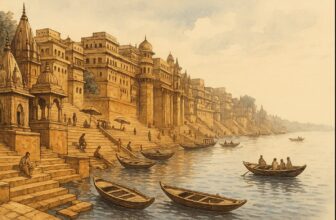Monsoons in India aren’t just about puddles and traffic jams. When you move away from cities, the landscape transforms. Forests revive, waterfalls swell, and hill stations turn lush and cool. Travel during this season also comes with off-season perks, fewer tourists, discounted hotels, and a slower, more local pace.
While many avoid travel during the rains, those who plan smart find magical destinations, lower rates, and the rare charm of seeing nature fully recharged. This listicle takes you through 18 handpicked places that become dramatically beautiful during the monsoon.
Western Ghats and Southern Hills
1. Munnar, Kerala
Rain clouds roll through the tea-covered slopes of Munnar between June and August. Mist clings to the winding roads, while waterfalls like Attukad and Lakkam reach their strongest flows. It’s also a great time for quiet stays in rainforest lodges.
2. Mahabaleshwar, Maharashtra
Monsoon mists transform this plateau into a cooler, greener version of itself. Venna Lake stays active even in light rain, while viewpoints like Arthur’s Seat and Elephant’s Head offer foggy, dramatic landscapes.
3. Agumbe, Karnataka
Agumbe receives over 7,000 mm of rain annually, making it one of the wettest places in South India. The Barkana and Onake Abbi Falls peak in monsoon. Wildlife researchers often visit for its rich rainforest ecosystem and king cobra habitat.
4. Coorg, Karnataka
Known for its coffee estates, Coorg during monsoon turns deep green. Abbey Falls flows stronger, and forest trails like Pushpagiri or Tadiandamol get misty. River rafting in Barapole is often allowed in July-August.
5. Lonavala-Khandala, Maharashtra
These twin hill stations near Mumbai become weekend favourites during the rains. Waterfalls are everywhere, especially Bhushi Dam, Tiger Point, and Rajmachi. Treks get slippery, so good shoes are essential.
6. Wayanad, Kerala (New)
Located between Kannur and Kozhikode, Wayanad offers forest treks, tribal villages, Edakkal caves, and waterfalls like Meenmutty and Soochipara. It’s perfect for road trips and nature photography in rain.
7. Kudremukh, Karnataka (New)
Kudremukh’s rolling green meadows resemble Scottish highlands during monsoon. The trek through Kudremukh National Park is allowed with forest permits and becomes a stunning journey across cloud-covered grasslands.
Himalayan and North-East Escapes
8. Valley of Flowers, Uttarakhand
Only open from June to early October, the valley reaches peak bloom between late July and mid-August. With over 600 flower species, clouded trails, and glacier-fed rivers, it’s one of India’s most unique monsoon-only destinations.
9. Ziro Valley, Arunachal Pradesh
Ziro sees fog drifting through pine trees and paddy fields. It’s quiet during monsoon, and you’ll get to witness the Apatani community working in rice terraces under cloud-covered skies.
10. Cherrapunji & Mawsynram, Meghalaya
World-famous for rainfall records, these towns burst with waterfalls like Nohkalikai and Seven Sisters. Living root bridges grow stronger in rain, and the region feels like a subtropical rainforest.
11. Tawang, Arunachal Pradesh
Tawang is safest to visit in early monsoon (late June-early July) before road access gets risky. Monasteries, lakes like Pankang Teng Tso, and views of distant snow peaks under cloud cover make it a peaceful escape.
Cultural and Urban Monsoon Backdrops
12. Mount Abu, Rajasthan
Rajasthan’s only hill station sees brief but welcome monsoon showers. Nakki Lake, the wildlife sanctuary, and Dilwara Jain temples look refreshed. Pleasant for short getaways from Udaipur or Ahmedabad.
13. Udaipur, Rajasthan
When monsoon rains fill the lakes, Udaipur transforms. Sajjangarh Fort (Monsoon Palace) earns its name, offering sweeping views of a rain-soaked lake city. Palace walks and boat rides feel cooler and more serene.
14. Goa (Hinterland)
Skip the beach scene and head inland. Waterfalls like Dudhsagar are full, spice plantations near Ponda are open for tours, and monsoon festivals like Sao Joao bring locals together in water-filled celebrations.
Less-Known But Ideal in Rain
15. Bhandardara, Maharashtra
A quiet spot near Nashik, known for Umbrella Falls and the Arthur Lake reservoir. Firefly sightings in early June attract photographers, and the greenery lasts through September.
16. Saputara, Gujarat (New)
Gujarat’s only hill station turns misty and cool during monsoon. Sunrise Point and Saputara Lake offer calm, scenic views. The town also hosts a monsoon festival organized by Gujarat Tourism.
17. Kodaikanal, Tamil Nadu (New)
Unlike Kerala’s heavy rain, Kodaikanal gets lighter monsoon showers. Berijam Lake, forest roads, and shola meadows become peaceful and mist-wrapped. Ideal for those who want mild rain without stormy conditions.
18. Chikmagalur, Karnataka (New)
This coffee town offers rolling plantations, forest trails, and waterfalls like Manikyadhara. Monsoon clouds hover low, making early morning drives and treks especially scenic.
Monsoon Exploration Planning Tips
Best Travel Window by Region:
- June-July: Kerala, Maharashtra, Goa
- July-August: Karnataka, Meghalaya, Rajasthan
- August-September: Uttarakhand, Arunachal, Tamil Nadu
What to Carry:
- Waterproof backpacks, dry bags, quick-dry clothes
- Trekking poles for steep terrain
- Rain poncho or jacket
- Power banks, offline maps, insect repellent
- Leech socks if visiting rainforests (Agumbe, Wayanad, Meghalaya)
Precautions:
- Always check weather forecasts and road advisories
- Avoid night travel in hilly regions
- Book local guides for treks
- Confirm homestay access, especially in remote locations after rainfall
FAQs About Monsoon Travel in India
Is it safe to visit hilly areas during monsoon?
It depends on the region. South India’s hill stations (like Coorg, Munnar) and Maharashtra’s ghats are generally safe. Himalayan regions may see landslides, always check updates and avoid risky treks.
Can I visit national parks in the rain?
Most tiger reserves (like Ranthambhore or Corbett) close during monsoon. However, you can still visit places like Silent Valley in Kerala or Buxa in Bengal with local permissions.
When is the best time to see the Valley of Flowers?
Late July to mid-August offers the highest bloom density. Avoid visiting too early or late, as snowmelt and rain timing affects flower cycles.





